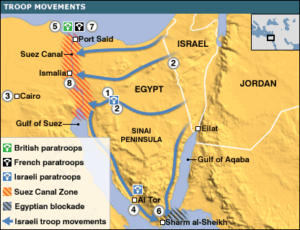In News: Low tide overnight has slowed efforts to dislodge a massive container ship that has choked traffic in both directions along the Suez Canal and created one of the worst shipping jams seen in years.
About Suez Canal
- Location: The Suez Canal is a sea-level waterway in Egypt, connecting the Mediterranean Sea to the Red Sea through the Isthmus of Suez. It extends from the northern terminus of Port Said to the southern terminus of Port Tewfik at the city of Suez.
- Authority Over Canal: The canal is owned and maintained by the Suez Canal Authority (SCA) of Egypt.
- Convention of Constantinople: Under Convention it may be used “in time of war as in time of peace, by every vessel of commerce or of war, without distinction of flag”.
- Importance of Canal: The canal offers watercraft a more direct route between the North Atlantic and northern Indian oceans via the Mediterranean and Red seas, thus avoiding the South Atlantic and southern Indian oceans.
History and Timeline
- Canal Constructed by the Suez Canal Company between 1859 and 1869
- Canal officially opened on 17 November 1869.
- The UK and France owned the canal until July 1956.
- President of Egypt, Gamal Abdel Nasser, nationalized it IN 1956. This event led to the Suez Crisis of October-November 1956.
- Egypt opened a major expansion of the canal in August 2015, deepening the main waterway and providing ships with a parallel 22-mile channel. The expansion allows two-way traffic along part of the route for the first time and the passage of larger vessels.
Suez Crisis
- The Israeli army struck first on October 29, 1956, with the British and French forces joining suit later. The original plan was to strike at once but transportation issues of the French and British troops had caused a delay.
- The joint offensive saw the Egyptian forces lose complete control of the canal area and it would seem that the canal would be lost, but Nasser rallied his country’s army and fought on.
- The delay in the offensive had given the Soviet Union, allies of the Egyptians, time to respond. The Soviet Union eager to gain influence in the middle east supplied arms and ammunition to the Egyptian army. Soviet leader Nikita Khruschev went as far as threatening to rain nuclear missiles on Western Europe should the Israeli-French-British force not withdraw in time
- The response of the United States warned that should the British, French and the Israelis not withdraw from the Suez Canal, his government would impose economic sanctions on all three.
- This worked and the British and French forces withdrew by December 1956 while the side of the canal towards the Sinai would be held by the Israelis until March 1957.
- The Suez Crisis marked the first use of a United Nations peacekeeping force. The United Nations Emergency Force (UNEF) was an armed group dispatched to the area to supervise the end of hostilities and the withdrawal of the three occupying forces.

















